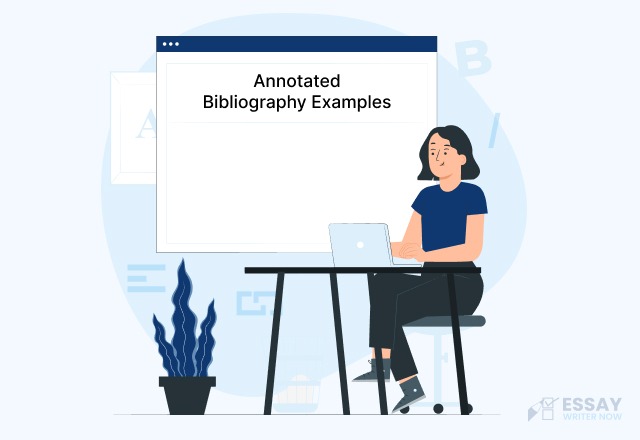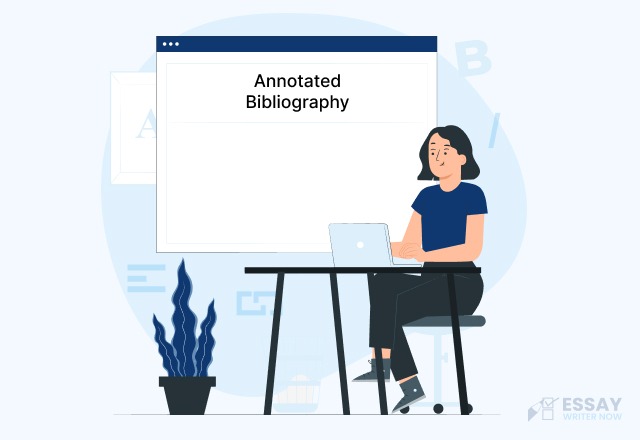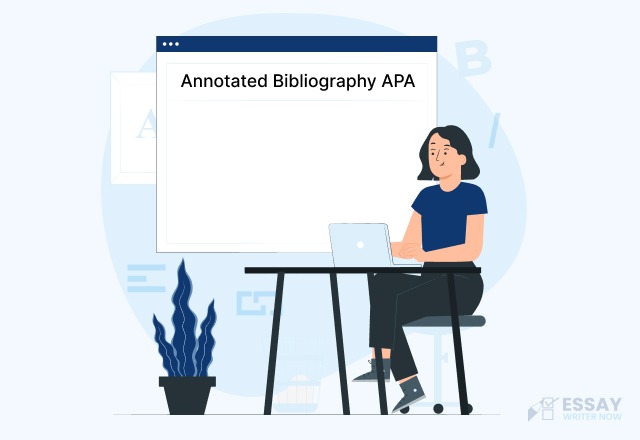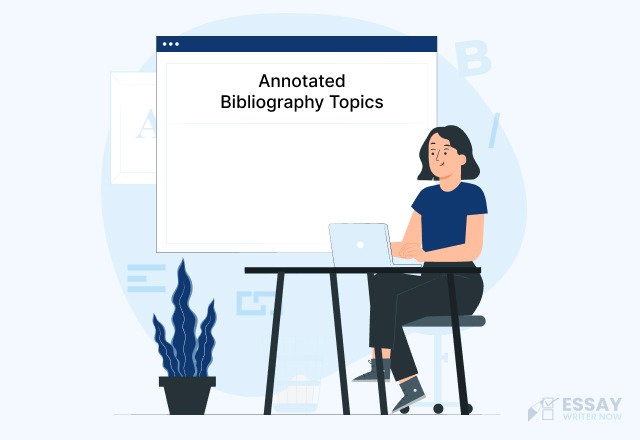What is an Annotated Bibliography?
An annotated bibliography is a list of citations to books, articles, and other sources. Each citation is followed by a brief (usually about 150 words) descriptive and evaluative paragraph, the annotation. The purpose of the annotation is to inform the reader of the relevance, accuracy, and quality of the sources cited.
Annotated bibliographies can be a great way to summarize the sources you are using for your research and provide insights into their importance and how they contribute to your work.
What does an Annotated Bibliography Look Like?
An annotated bibliography looks like a standard bibliography but with more detail added below each citation. Instead of just listing the sources, it includes a few sentences that give more information about each source. These sentences can include a summary of what the source is about, an evaluation of how credible it is, and a reflection on how useful it is for your research.
Here’s a basic structure for an annotated bibliography:
Citation: This is the same as any regular bibliography. You need to follow the format your instructor or the style guide you’re using requires.
Example:
Smith, John. Understanding Annotated Bibliographies. New York: Academic Press, 2020.
Annotation: This part is added below the citation and usually includes three main elements:
- Summary: A brief overview of the main points or arguments of the source.
- Evaluation: An assessment of the source’s reliability, accuracy, and quality. You can mention if the source is well-researched, if the author is an expert, and how credible the information is.
- Reflection: How the source fits into your research. Explain why you chose this source, how it helps your work, and what specific information it provides that is useful.
Example Annotation:
This book provides a comprehensive overview of annotated bibliographies. Smith covers the history, purpose, and structure of annotated bibliographies in a clear and concise manner. The book is well-researched and includes numerous examples and tips for writing effective annotations. This source is valuable for understanding the fundamentals of annotated bibliographies and will be useful for guiding my own writing.
By including these elements, an annotated bibliography not only shows what sources you are using but also gives insight into their relevance and quality. This makes it easier for others to understand the context of your research and the resources you have relied on.
How To Write An Annotated Bibliography Example
When writing annotated bibliographies, there are a few key points to remember:
Choose Your Sources
Start by selecting sources that are relevant to your topic. These should be books, articles, or other resources that provide valuable information. Make sure to pick sources that will add depth to your research and help you understand the topic better.
Cite the Source
Once you have your sources, you need to cite them correctly. Follow the format required by your instructor or the style guide you are using. Common citation styles include APA, MLA, and Chicago. A citation typically includes the author’s name, title of the work, publication date, and other relevant details.
Example: Smith, John. Understanding Annotated Bibliographies. New York: Academic Press, 2020.
Summarize the Source
After citing the source, write a brief summary of its main ideas. This summary should cover the key points the author makes and the overall purpose of the work. Keep it concise and focused on the main arguments or findings.
Example Summary:
This book provides a comprehensive overview of annotated bibliographies. Smith covers the history, purpose, and structure of annotated bibliographies in a clear and concise manner. |
Evaluate the Source
Next, evaluate the source’s credibility and reliability. Ask yourself questions like: Is the author an expert in this field? Is the information well-researched and supported by evidence? Is the source up-to-date? This evaluation helps you and your readers understand the quality of the source.
Example Evaluation:
The book is well-researched and includes numerous examples and tips for writing effective annotations. Smith is a recognized expert in the field, which adds to the credibility of the information. |
Reflect on the Source
Finally, reflect on how the source fits into your research. Explain why you chose this source, how it helps your work, and what specific information it provides that is useful. This reflection shows the relevance of the source to your research and how it contributes to your understanding of the topic.
Example Reflection:
This source is valuable for understanding the fundamentals of annotated bibliographies and will be useful for guiding my own writing. It provides clear explanations and practical examples, which will help me create effective annotations. |
Sample Annotated Bibliographies
Annotated Bibliography Example Wang, J. (2019). Exploring the impact of digital technology on education in developing countries. International Journal of Education and Development Using Information and Communication Technology, 15(2), 45-58. This article examines the impact of digital technology on education in developing countries. The author argues that while there are many benefits to the use of digital technology in education, there are also some potential drawbacks. The article draws on a range of sources and provides an in-depth analysis of the topic. It is well-written and provides valuable insights into the subject matter. |
Introduction For Annotated Bibliography Example Kirk, A. (2015). Technology in Education. Reading, MA: Addison-Wesley. This book provides an overview of the use of technology in education, exploring its potential benefits and drawbacks. It looks at how technology can be used to enhance the learning experience, how teachers can use technology to engage students, and how technology can help with assessment. The author draws on research from a range of sources to support her arguments. This book is well-researched and provides an in-depth analysis of the topic. |
Annotated Bibliography Example APA
APA stands for the American Psychological Association and it is widely used in psychology, education, and other social sciences.
An annotated bibliography APA should include the following elements:
- Citation of the source in APA style
- Brief description and assessment of the source.
- Information about the source’s author, such as their credentials or affiliation to a relevant organization.
Make sure to strictly follow the APA style standards when structuring your annotated bibliography. Also, double-check that each citation is both precise and thoroughly detailed.
For an illustration of what a completed APA annotated bibliography looks like, have a look at the following example:
Annotated bibliography Example APA 7
The APA 7 version of annotated bibliographies follows the same format as annotated bibliographies in previous versions. However, there are a few important changes that must be noted.
- First, all annotations must include a brief summary of the source’s content and an evaluation or assessment of its credibility.
- Second, these bibliographies include a header that includes the full title of the annotated bibliography.
- Finally, double-check that each citation style is accurate and follows APA 7 standards.
To gain a better understanding of an annotated bibliography example APA 7, take a look at this example:
Annotated Bibliography Example MLA
MLA stands for the Modern Language Association and is used for citations in the humanities, such as literature, philosophy, and history.
An annotated bibliography MLA example should include the following elements:
- Citation: According to MLA style, this source must be cited.
- Description and Assessment: This resource provides a comprehensive overview of the topic in question. It should be complete with detailed information that is both accurate and up-to-date.
- Author Information: This includes the author's credentials as well as their expertise in the field.
To give you an idea of how it looks, here's a sample annotated bibliography in MLA:
Annotated Bibliography Example MLA 9
MLA annotated bibliographies are structured in accordance with the 9th edition of the MLA handbook.
The main difference between annotated bibliographies in previous versions and annotated bibliographies in MLA 9 is that annotations should be concise.
All annotated bibliographies must now include a brief summary of the source’s content.
Also, annotated bibliographies should include a header that contains the full title of the annotated bibliography and any relevant assignment details.
Here’s an example of an annotated bibliography in MLA 9 format:
Annotated Bibliography Example Chicago
Chicago annotated bibliographies follow the style guidelines of The Chicago Manual of Style.
An annotated bibliography example in Chicago should include the following elements:
- The citation entry: This should include all of the relevant information making up a chicago style bibliography entry. This includes author name(s), title, publisher and date.
- Annotation: The annotated bibliography should also include a brief summary of each source and its usefulness to your project. Depending on the length of the annotated bibliography, this annotation will usually be about 150 words in length.
- Evaluation: Each annotated entry should also contain an evaluation of the source. This may include a description of the author’s expertise or any potential bias or objectivity issues.
To get a better idea of how an annotated bibliography in chicago style looks like, take a peek at our example!
Annotated Bibliography Example Harvard
Harvard annotated bibliographies follow the Harvard style guidelines. An annotated bibliography example in Harvard should have the following features:
- The first feature is the citation entry. This should include all of the relevant information making up a Harvard style bibliography entry. Including author name(s), title, publisher and date.
- Second is the annotation. The annotated bibliography should also include a brief summary of each source and its relevance to your project. Depending on the length of the annotated bibliography, this annotation will usually be about 100 words in length.
- Third is an evaluation of the source. Each annotated entry should also contain an evaluation of the source. This may include a description of the author’s expertise, their persuasiveness and accuracy.
Annotated Bibliography Example Turabian
Turabian annotated bibliographies follow the style guidelines of Turabian's Manual for Writers of Research Papers, Thesis, and Dissertations.
When crafting an annotated bibliography in Turabian format, be sure to include the following components:
- Ensure that each Turabian style bibliography entry contains all the necessary elements. This includes author name(s), title, publisher and date for maximum accuracy.
- For each entry in the annotated bibliography, a concise summary of its relevance and value to your project should be included. Generally speaking, annotations for an annotated bibliography should not exceed 100 words per source.
- For each source, an appraisal of its quality should be included. This includes a review of the author's credentials and potential for persuasion as well.
Different Types of Annotated Bibliography Examples
Despite having a shared structure, annotated bibliographies may bear slight variations depending on the style of citations utilized.
Indicative Annotated Bibliography
An indicative annotated bibliography provides a summary of the source without evaluating its content. It simply gives an overview of the main ideas.
Indicative Annotated Bibliography Example Smith, John. "The Impact of Climate Change on Human Health." Journal of Environmental Health, vol. 34, no. 1, 2020, pp. 32-41. An overview of the effects that climate change has had on human health in recent years. Focuses on how climate change is linked to an increase in certain illnesses, such as asthma and cardiovascular diseases. |
In this type of annotation, the focus is on describing what the source is about. It gives a brief overview, letting the reader know the main topics covered. It doesn't delve into how useful or reliable the source is, just what it contains. This type is useful when you want to compile a list of sources and their primary content without going into detailed analysis.
Informative Annotated Bibliography
An informative annotated bibliography includes both a summary and an evaluation of the source. It provides information about the content as well as the relevance and credibility of the source.
Informative Annotated Bibliography Example Davis, J. (2015). Workplace Diversity: Strategies and Benefits for Businesses. In G. Hough (Ed.), Encyclopedia of Global Human Resource Management (pp. 270-274). New York: Routledge. This article, written by an experienced HR professional, is a comprehensive guide to developing workplace diversity strategies and highlights their potential benefits for a business. The author defines key terms and provides an in-depth discussion of how to create an effective diversity strategy in the workplace. This source makes valuable contributions to the study of human resource management and would be useful to someone researching ways to improve workplace diversity. |
This type of annotation not only tells what the source is about but also gives an assessment of its quality. It includes information on how the source contributes to the topic, its strengths, and why it is reliable. This helps readers understand both the content and the value of the source for research purposes.
Evaluative Annotated Bibliography
An evaluative annotated bibliography focuses on evaluating the source rather than just summarizing it. It provides a critical assessment of the source’s strengths and weaknesses.
Evaluative Annotated Bibliography Example “Smith, John. The Art of Cooking. Oxford Press, 2017. This book is an up-to-date and comprehensive guide to the art of cooking, aimed at amateur chefs who wish to improve their culinary skills. Smith provides clear instructions on a wide range of recipes, along with helpful advice and tips for getting the most out of the cooking experience. The book is well-researched and includes a wealth of information on techniques, ingredients, and equipment. This is an excellent resource for anyone looking to become a better cook.” |
Here, the annotation critically examines the source. It highlights both the positives and negatives, helping the reader gauge its usefulness and any potential limitations. This type is particularly helpful when you need to decide which sources are the most valuable or relevant to your research.
Combination Annotated Bibliography
A combination annotated bibliography includes elements of summary, evaluation, and reflection. It provides a comprehensive overview of the source and its usefulness for your research.
Combination Annotated Bibliography Example Smith, J.A. (2006). Gender and Language in the Workplace. Annual Review of Applied Linguistics, 26(1), 3-25. This is an excellent source that discusses gender and language in the workplace. It provides an overview of current research on the topic and presents an analysis of the findings. It concludes by making suggestions for future research. |
This type of annotation gives a complete picture of the source. It summarizes the content, evaluates its quality, and reflects on its applicability to your research. It’s useful for readers who need a thorough understanding of what the source offers and how it fits into their work.
To learn more, watch this informative video.
In conclusion, putting together an annotated bibliography might feel like extra work, but it’s a key step in making your research clear and organized. By summarizing what each source is about, evaluating its credibility, and reflecting on how it fits into your work, you create a helpful tool for yourself and others.
The practical examples shared in this guide will make it easier to write annotated bibliographies across different citation styles. With these insights, you’ll be able to build a well-structured annotated bibliography that strengthens your research and makes it more accessible.




